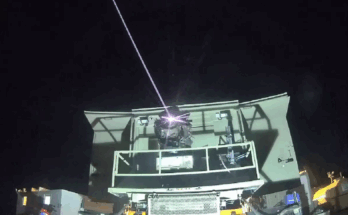
As the recent, unprecedented, and devastating drone attack on Russia’s air force has demonstrated, the need for counter-drone, or C-UAS, technology is not only more pressing than ever but goes beyond the immediate demands of forward deployed positions. The nature of the elaborately planned and executed action, in which UAS evidently had already been positioned beyond any early detection and defense measures before attacking, also illustrates that a strategy of multiple layers of different kinds of C-UAS is likely the only truly effective way to deal with the threat.
Military planners worldwide are no doubt paying close attention to these latest developments and are calling on industry to keep advancing the refinement and accessibility of C-UAS technology against a constantly evolving threat environment. The past month of May saw some of the year’s most intense activities in this effort.
On the business and contracting front, May 1 saw the announcement by AeroVironment, Inc. of their acquisition of C-UAS and autonomous systems provider, BlueHalo, LLC. According to AeroVironment, among other technology services, the move will strengthen their position as a provider of C-UAS solutions across radio frequency, directed energy and kinetic defeat technologies, space technologies, and cyber and advanced solutions.
A few days later, on May 5, the U.S. DoD’s Defense Innovation Unit (DIU) and U.S. Northern Command (NORTHCOM) introduced two new opportunities for industry to bring forward CUAS capabilities. Specifically, the announcement was a solicitation for low collateral defense (LCD) capabilities that will “scale across the joint force” and integrate into current small CUAS programs of record.
The goal of LCD systems, as expressed in the announcement, is to “help to minimize risk to friendly forces, civilians, and infrastructure in the homeland and abroad.” The DIU further planned to announce a prize challenge in partnership with NORTHCOM, seeking additional solutions to detect, identify, and track UAS.
On May 14, the U.S. announced a $1 billion defense agreement with Qatar, establishing the Gulf nation as the first international customer of the Fixed Site Low, Slow, Small Unmanned Aircraft System Integrated Defeat System (FS-LIDS) to help address the UAS threat across the Middle East.
The FS-LIDS CUAS solution is a program being advanced by a partnership consisting of Raytheon, SRC Inc. and Northrop Grumman. The system integrates radar, advanced cameras, electronic warfare tools, and kinetic interceptors and is part of a broader LIDS family, which also includes a mobile variant known as M-LIDS for more flexible deployments.
The agreement with Qatar includes the delivery of ten FS-LIDS systems, 200 Coyote Block 2 drone interceptors, along with their associated launchers, and a full suite of support services.
A day or so after the U.S./Qatar announcement, Norwegian technology firm, KONGSBERG and Naval Group signed a comprehensive partnership agreement, revolving around four main areas: development, production, support, and shared marketing in the international market. Among the many subtopics of the agreement, the area of C-UAS solutions was prominently identified.
Meanwhile in Germany, the Federal Office of Bundeswehr Equipment, Information Technology and In-Service Support (BAAINBw) on May 16 commissioned the sensor provider Hensoldt to enhance the functional capabilities of the ASUL drone defense system. ASUL features a scalable sensor-effector mix of complementary active and passive radar systems, electro-optical sensors and a range of countermeasures.
According to the announcement, Hensoldt will “expand ASUL in a targeted manner to deliver the capability enhancements required by the soldiers of the Bundeswehr.”
On May 27 QinetiQ US won a $41 million, three-year task order to provide software and technology integration support for a CUAS project under the U.S. Army Combat Capabilities Development Command (DEVCOM) C5ISR Center. The company is tasked with advancing C-UAS capabilities across fixed installations, vehicles, and mobile deployment systems. QinetiQ is further expected to support key aspects of the program including development, testing, deployment and training.
Finally, Canadian armored vehicle manufacturer Roshel on May 28 announced the Senator Counter-UAS Vehicle, developed in partnership with Leonardo UK. According to Roshel, the Senator Counter-UAS Vehicle is based on the company’s existing Senator Pickup MRAP (Mine-Resistant Ambush Protected) platform and incorporates Leonardo’s Falcon Shield C-UAS technology.
Join Forecast International at the Paris Air Show to gain valuable insight into the evolving dynamics of the global defense market. Traditionally regarded as insulated from broader economic fluctuations, the defense sector is now increasingly impacted by global economic forces. Tariffs, trade disputes, and rising economic nationalism are introducing new complexities that affect the stability, cost-efficiency, and resilience of critical defense programs. Visit us at Hall 3, Booth C164 to learn how our expert analysis can strengthen your planning and elevate your strategy.
Schedule a time to meet with us in Paris.
Andrew Dardine is lead analyst for Forecast International's Defense Electronic Systems group. He is the primary author of Forecast International's Electronic Warfare Forecast and co-author of Electro-Optical Systems Forecast and C4I Forecast. Andrew is also a regular contributor to FI's Defense & Security Monitor blog, offering insights into developing technologies such as directed-energy and next-generation jamming systems. His analysis of such vital market areas as EO/IR systems and electronic countermeasures technology has been cited in Defense News, Aerospace Daily, and Bloomberg Businessweek, among other news media. He has also written about the electronic defense market for Aviation Week and the Journal of Electronic Defense.





